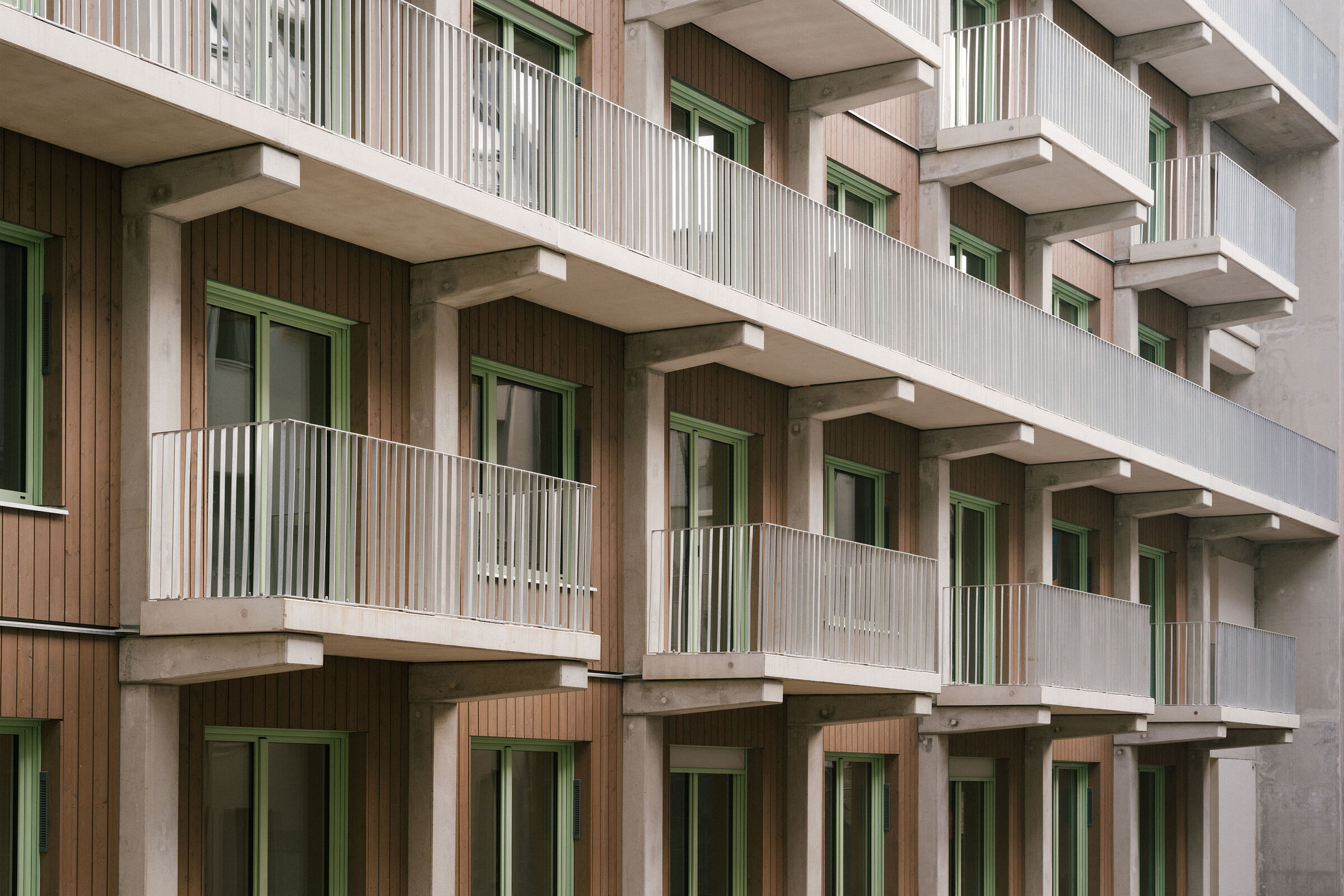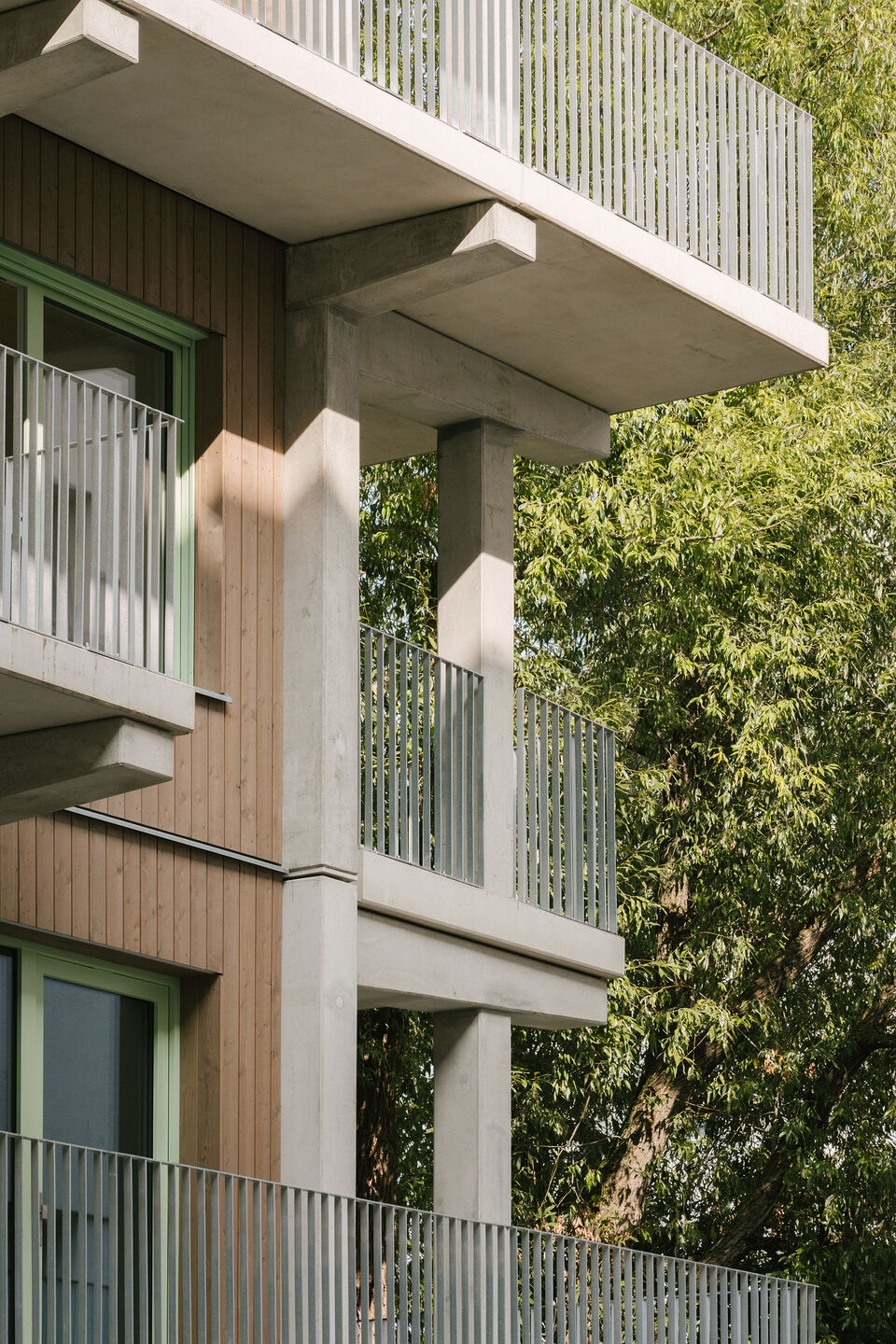
 |  |  |
Studio LOES creates new living spaces in a dense inner city Berlin district
기존 도시공간에서 지속가능한 건축을 목표로 시작된다. 목재모듈과 조립식 콘크리트를 사용하여 효율적이며 생태학적으로 지속가능한 건축방식을 제안한다. 총 5층 규모의 아파트먼트는 57~101제곱미터의 크기의 유닛이 복층형태로 구성된다. 발코니와 각 유닛을 연결하는 복도를 외부에 배치함으로써 거주자끼리의 커뮤니티 활성화를 도모한다.

HOUSE REFERANCE




















Berlin’s inner city Moabit district is an area characterized by its dense perimeter blocks. It is here that Berlin based Studio LOES has been extending and adding to two existing residential buildings from Germany's Wilhelmine Period (1890 – 1918) and post-war period. The project incorporates the construction of a new “garden house” (dubbed “Element”) on an inner courtyard that sits between the two existing buildings. In addition, these two buildings have been extended upwards with new rooftop apartments (dubbed “Lingot”).
Solving the challenge of creating new living spaces in a densely packed area, Element and Lingot are two concurrent developments distinguished by the use of wooden modules and prefabricated concrete elements, allowing for “a very efficient and ecologically sustainable construction method,” says Studio LOES. The project “sets an example for intelligent redensification (sic) in a confined inner city space,” adds the studio. The work echoes the pleas of Italian architect and historian Vittorio Magnago Lumpugnani in a recent essay titled “Gegen Wegwerfarchitektur” (Against disposable architecture). In his essay, Lumpugnani calls for building less, dense, and more permanent architecture.
Element is a multi story residential building that comprises five floors plus a stacked floor. The structure has a total of twenty apartments, including several maisonettes, measuring between 57 – 101 square meters (614 – 1,087 square feet) — Element’s gross floor area is 2,600 square meters (27,986 square feet) “The exoskeleton of prefabricated reinforced concrete elements ‘turned inside out’ forms the balconies of the apartments and transforms [external] stairwells and arcades into public areas available for use by residents,” says Studio LOES. By separating the circulation system from the building’s interior, apartments are freely arranged vertically and horizontally. With the building’s south-east orientation, spacious terraces and balconies on the east facade benefit from warm sunlight. Services are housed externally in the reinforced concrete skeleton, behind which sits a timber-framed facade with prefabricated windows and doors. On the interior, cross-laminated timber walls and ceilings act as load-bearing elements. The use of prefabrication reduced both construction time and noise pollution.
In the development of Lingot, roof extensions to the existing buildings complement Element’s development. Four new penthouse apartments, also built using prefabricated wooden modules and precast concrete elements, were placed on the flat rooftops of each building. Lingot contains a total of eight apartments that measure between 54 75 square meters (581 – 807 square feet) and feature extended balconies — the total gross floor area is 770 square meters (8,288 square feet) “The roof form reinterprets that of the ‘Berlin roof’ with variance in height and vertical slopes,” says Studio LOES. “In this way, both roof extensions blend harmoniously with the surrounding buildings.” Residents access the new apartments via an extension to the existing staircases. In both Element and Lingot, residents benefit from cross-ventilation and year-round sunlight. The two developments feature green roofs, photovoltaic panels, and heat pumps.
from archello
'House' 카테고리의 다른 글
| *루프테라스 공동주택 PSLA Architekten tops urban townhouse with cascading roof terraces (0) | 2023.11.20 |
|---|---|
| *이스트 웨스트 하우스 [ Bloot Architecture ] East West House (0) | 2023.11.17 |
| *맨션 리모델링 [ MINUIT ] MAISON MORVAN (0) | 2023.11.15 |
| *사막 위에 모던 건축 architects woods + dangaran to camouflage modern 'moccasin flats' w (0) | 2023.11.14 |
| *우드 박공지붕 [ Oza Sabbeth Architects ] Ditch Plains (0) | 2023.11.13 |